CD V-715 Ion Chamber Survey Meter (ca. 1961-1964)
The CD V-715 is “a high-range gamma survey meter for general post attack operational use” that employs a hermetically sealed ionization chamber. All the models (1, 1A, 1B) of the 715 were transistorized, and like other CDV ion chamber survey meters (e.g., the CD V-710), the CD V-715 had two controls: a zero adjust knob and a range switch.
While the CD V-710 and the CD V-720 had three ranges, the CD V-715 had four. This allowed the CD V-715 to span the range of both. According to the Handbook for Radiological Monitors (1963), the CD-715 superseded both the CD V-710 and the CD V-720. When the CD V-715 was first produced (in 1961 or 1962), the government disposed of its entire inventory of CD V-710s and roughly 40% of its CD V-720s.
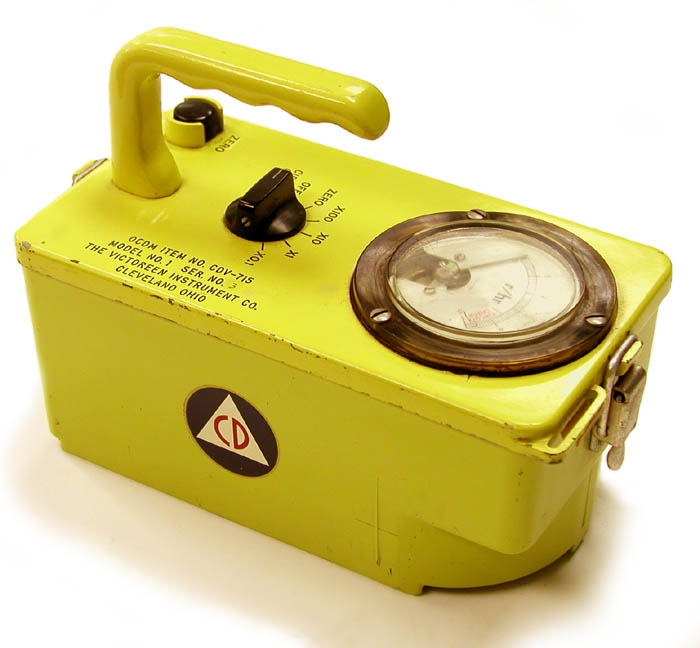
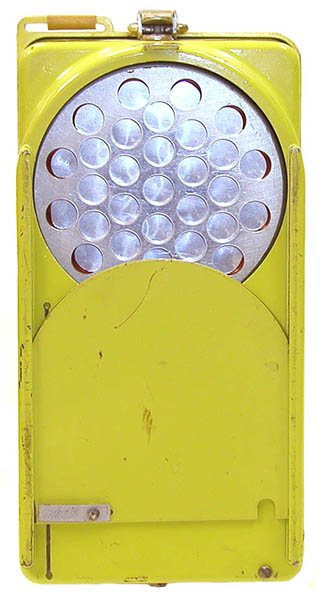
There is good reason to believe that the Victoreen Instrument Company was responsible for developing the CD V-715. According to an article in the November 1961 issue of Nucleonics: "Victoreen has developed a portable survey meter with an ion chamber detector having four decades of range (0-0.5, 0-5, 0-50, 0-500 r/hr) that is accurate to ±15% in detecting beta and gamma radiation." Sounds like the 715 to me. In addition, the 1961 Annual Report from the Office of Civil and Defense Mobilization refers to Victoreen's development of a prototype survey meter (the CD V-716x) that "combining the range, accuracy and general operating characteristics of the V-710 and V-720 survey meters... capable of indicating beta radiation on all ranges."
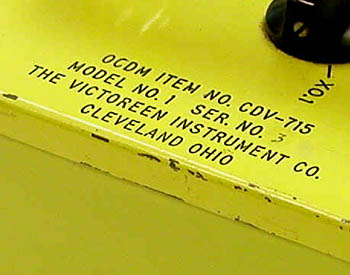
The conventional wisdom is that Victoreen didn't produce any Model 1s, just the Models 1A and 1B. Nevertheless, the instrument pictured above (donated by the Victoreen Company) is identified as CDV-715 Model No.1 Serial No. 3 (see photo right).
What makes this Victoreen unit especially unique is the fact the detector is capable of responding to beta radiation just like the CD V-720! The standard CD V-715 (see below) had no such beta detection capability. It is possible this is a prototype and that Victoreen's original intent was that their version of the CD V-715 employ the same chamber as the CD V-720. For whatever reason, a Victoreen Model 1 never went into large scale production. The fact that this instrument refers to the "OCDM" indicates that it was produced earlier than the Victoreen CD V-715 Models 1A and 1B because those instruments refer to the "OCD" item number. The OCDM became the OCD in 1961.
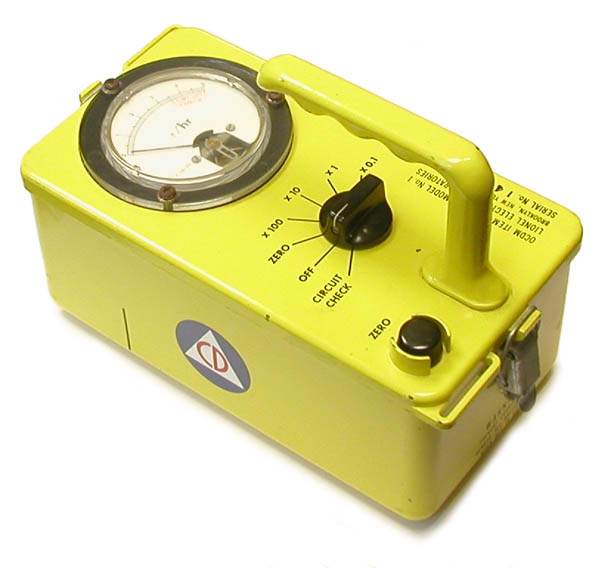
Lionel CD V-715 Model 1
Learn about another interesting early version of a Victoreen CD V-715—the Model 815A.
The instrument to the right, a Lionel Electronics Model 1, is what the CD V-715 is "supposed" to look like. The base has a square rather than rounded front end. This indicates that it lacks the beta detection capability of the instrument pictured at the top of the page.
Lionel Electronics was part of the same Lionel company that made toy trains. Learn more about Lionel's entry into the nuclear business.
In September 1964, FEMA sent a notification to the maintenance and calibration facilities that the Lionel Models 1 and 1A of the CD V-715 were obsolete.
Donated by William Bashaw III.
The Model 1A differs from the Model 1 in that it supplies a greater high voltage to the ionization chamber.
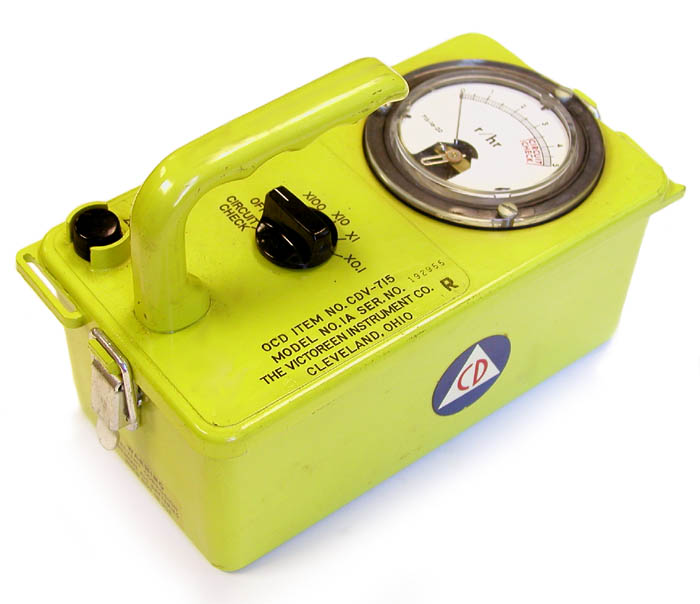
Victoreen CD V-715 Model 1A
Note the black "R" just beneath the serial number on the Model 1A (photo to right). This stands for "retrofit."
Almost as soon as the original CD V-715s went into production, the California Branch of the OCD (the California Disaster Office) field tested instruments from the three manufacturers. A number of different problems were identified and Oak Ridge National Laboratory was asked by the OCD to investigate. Of primary concern were calibration shifts, excessive battery drain and an unreliable circuit (battery) check. The calibration shifts seemed to be due to changes in the input resister and leakage currents in high humidity conditions.
The result was the establishment of a retrofit program wherein a number of modifications were made to the instrument at the RIM&C facilities. These modifications are described in FEMA's CPG 4-1. Among other things, the retrofits typically involved replacing the old hydrophilic high-meg resister with an all-glass version. If there was a problem with the meter, it was replaced with a ruggedized version that can be identified by the black ring around it.
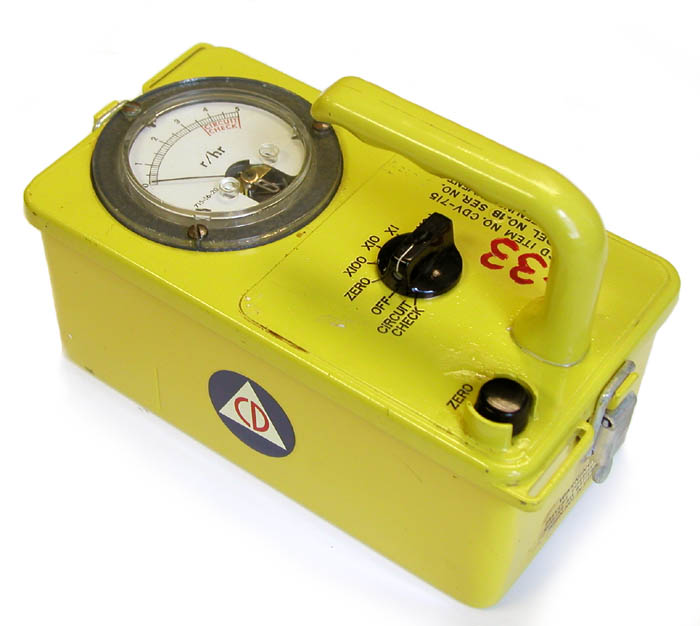
Victoreen CD V-715 Model 1B
FEMA's 1991 publication Use of Civil Defense Radiological Instruments for Peacetime Radiological Emergencies stated: "It is important to ensure that ONLY retrofitted CD V-715 instruments are being used. All retrofitted instruments have an "R" stamped on the case top at the location of the nomenclature." The first retrofits of the CD V-715 began in 1971.
This document recommended that the instrument should be turned on for an "extended period, e.g., 8 hours or longer)" every so often (quarterly?) and that the instruments be stored with the batteries removed and a package of desiccant inside the case.
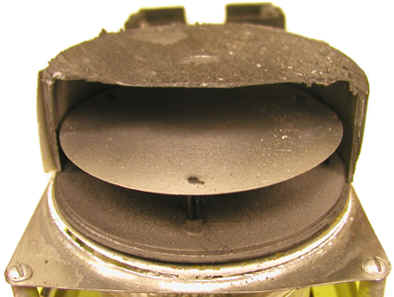
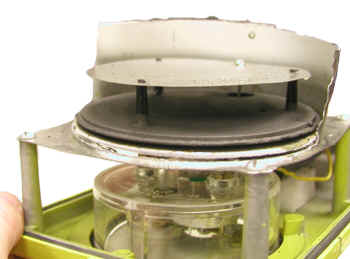
The outer case of the 715's chamber is a metal can, and inside of that is a graphite shell that serves as the chamber's cathode. The photo above left shows the front of the graphite removed so that the central anode (a large circular metal disk supported by three posts) can be seen. In the photo above right, the graphite has been removed except for the horizontal plate that forms the bottom. The electrical connection to the central anode can be seen penetrating a small hole in the graphite towards the back side of the chamber.
It seems that moisture can sometimes get into the chamber and affect the calibration. In some cases, this problem can be corrected by drilling a small hole in the chamber wall, heating the instrument up, allowing it to return to room temperature in a dry environment, and soldering the hole.
Detector: Hermetically sealed ion chamber filled with dry air at atmospheric pressure.
Range: 0-0.5, 0-5.0, 0-50, 0-500 R/h
Size: 4.5” x 8.25” x 7”
Weight: 4 pounds
Batteries: One 1.5 volt D cell (the OCD specifications set a maximum of three).
Battery life: 150 hours of continuous use.
Materials: The case is aluminum while the panel and handle are diecast zinc.
Manufacturers: Victoreen Inst. Co. (Models 1A, 1B), Landers, Frary and Clark (Model 1A), and Lionel Electronic Labs (Models 1, 1A). The Landers, Frary and Clark Model 1As were almost identical to the Lionel Model 1A. The Victoreen instrument was significantly different in terms of its circuitry. The major difference between the Victoreen 1A and 1B was that the latter used nonlinear potentiometers to reduce the coarseness of the calibration adjustment characteristic of the Model 1A.
In 1961, Nicholas Anton (founder of Anton Electronic Laboratories that had been taken over by Lionel in 1960) started the EON Corporation and began producing a commercial version of this instrument, the PSM 715.
Estimated Dates of First Production:
- Model 1 ca. 1961, early 1962
- Model 1A ca. 1962
- Model 1B ca. 1964
Approximate Cumulative Procurement, Inventory and Distribution of CD V-715s*
| Fiscal Year | Procured | Inventoried | Distributed |
|---|---|---|---|
| FY 1961 | 11,729 ordered, none delivered | ||
| FY 1962 | 15,689 | 15,609 | 80 |
| FY 1963 | 567,475 | ||
| FY 1964 | 567,475 | ||
| FY 1965 | 567,475 | 402,406 | 107,547 |
| FY 1966 | 567,475 | 405,893 | 147,576 |
| FY 1967 | 567,475 | 382,354 | 181,865 |
| FY 1968 | 567,475 | 329,848 | 237,627 |
| FY 1969 | 567,475 | 286,774 | 280,690 |
| FY 1970 | 567,475 | 243,583 | 323,880 |
| FY 1971 | 567,475 | 85,247 | 400,822 |
| FY 1972 | 567,475 | 128,416 | 357,471 |
| FY 1973 | 567,475 | ||
| FY 1974 | 567,475 | 43,086 | 524,329 |
*The numbers in the above table should be considered approximate. I compiled them from data in the Annual Statistical Reports of the OCDM, OCD and DCPA. By "procured," I mean delivered by the manufacturer to the OCDM, OCD or DCPA. "Inventoried" means stored in a Federal (rather than state) warehouse ready for distribution. "Distributed" means sent to the end user. The latter primarily means the states, but also various federal agencies and even foreign governments. The number of procured instruments may be greater than the combined number of inventoried and distributed instruments for a variety of reasons: some may have been sent back to the manufacturer, some may have been disposed of, the numbers might be incorrect, etc.
References
- FEMA, Radiological Instruments: An Essential Resource for National Preparedness, CPG 3-1/September 1986.
- Office of Civil Defense Handbook for Radiological Monitors, FG-E-5.9, April 1963.
- De Lorenzo, J. T., Investigation of the OCD Radiological Survey Meter CD V-715, ORNL-TM-2145, March 12, 1968.
- Carl Siebentritt, personal communication.
- Instruction and Maintenance Manual, Lionel CD V-715 Model 1, 1961 - 62.
- Instruction and Maintenance Manual, Victoreen CD V-715 Model 1A, 1962.
- Instruction and Maintenance Manual, Lionel CD V-715 Model 1A, 1962.
- Instruction and Maintenance Manual, Landers, Frary and Clark CD V-715 Model 1A.
- Instruction and Maintenance Manual, Victoreen CD V-715 Model 1B, 1964.
